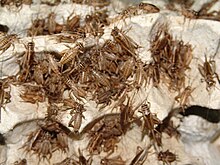Insect farming

Insect farming is the practice of raising and breeding insects as livestock, also referred to as minilivestock or micro stock. Insects may be farmed for the commodities they produce (like silk, honey, lac or insect tea), or for them themselves; to be used as food, as feed, as a dye, and otherwise.
Farming of popular insects
Silkworms
Mealworms
The
Buffaloworms
Buffaloworms, also called lesser mealworms, is the common name of
Honeybees
Commodities
Lac insects
, with over 2 million residential employees.Cochineal
Made into a red dye known as carmine, cochineal are incorporated into many products, including cosmetics, food, paint, and fabric. About 100,000 insects are needed to make a single kilogram of dye. The shade of red the dye yields depends on how the insect is processed. France is the world's largest importer of carmine.
Crickets

Among the hundreds of different types of crickets, the house cricket (Acheta domesticus) is the most common type used for human consumption.[4] The cricket is one of the most nutritious edible insects, and in many parts of the world, crickets are consumed dry-roasted, baked, deep-fried, and boiled. Cricket consumption may take the form of cricket flour, a powder of dried and ground crickets, which is easily integrated into many food recipes. Crickets are commonly farmed for non-human animal food, as they provide much nutrition to the many species of reptiles, fish, birds and other mammals that consume them. Crickets are normally killed by deep freezing.
Waxworms
Waxworms are the larvae of wax moths. These caterpillars are used widely across the world for food, fish bait, animal testing and plastic degradation. Low in protein but high in fat content, they are a valuable source of fat for many insectivorous organisms. Waxworms are popular in many parts of the world, due to their ability to live in low temperatures and their simplicity in production.[5]
Cockroaches
Cockroaches are farmed by the million in China, where they are used in traditional medicine and in cosmetics. The main species farmed is the American cockroach (Periplaneta americana). The cockroaches are reared on food such as potato and pumpkin peeling waste from restaurants, then scooped or vacuumed from their nests, killed in boiling water and dried in the sun.[6]
As feed and food
Insects show promise as animal feed. For instance, fly larvae can replace fish meal due to the similar amino acid composition. It is possible to formulate fish meal to increase unsaturated fatty acid.[7] Wild birds and free-range poultry can consume insects in the adult, larval and pupal forms naturally.[8] Grasshoppers and moths, as well as houseflies, have been used as feed supplements for poultry.[9] Apart from that, insects have potential as feed for reptiles, fish, mammals, as well as birds.[10]
Hundreds of species of crickets,
Benefits
Purported benefits of the use of insects as food include:
- Significantly lower amounts of resource and space use, lower amounts of waste produced, and emissions of very trace amounts of greenhouse gases.[14]
- They include many lean ground beef.[14]
- As opposed to meat, lower costs are required to care for and produce insects.[4]
- Faster growth and reproduction rates. Crickets mature rather quickly and are typically full-grown within 3 weeks to a month,[4] and an individual female can lay from 1,200 to 1,500 eggs in three to four weeks. Cattle, however, become adults at 2 years, and the breeding ratio is four breeding animals for each market animal produced.[16]
- Unlike meat, insects rarely transmit diseases such as mad cow disease, or salmonella.[14]
Reduced feed
Cattle use 12 times the amount of feed that crickets do to produce an equal amount of protein.[4] Crickets also only use a quarter of the feed of sheep and one-half the amount of feed given to swine and chicken to produce an equivalent amount of protein.[4] Crickets require only two pounds of feed to produce one pound of the finished product.[4] Much of this efficiency is a result of crickets being ectothermic, as in they get their heat from the environment instead of having to expend energy to create their own body heat as typical mammals do.
Nutrient efficiency
Greenhouse gas emissions
The raising of livestock is responsible for 18% of all greenhouse gases emitted.[4] Alternative sources of protein, such as insects, replace protein sourced from livestock and help decrease the number of greenhouse gases emitted from food production. Insects produce less carbon dioxide, ammonia and methane than livestock such as pigs and cattle, with no farmed insect species besides cockroaches releasing methane at all.[13]
Land usage
Livestock raising accounts for 70% of agricultural land use.[12] This results in a land-cover change that destroys local ecosystems and displaces people and wildlife. Insect farming is minimally space-intensive compared to other conventional livestock, and can even take place in populated urban centers.[12]
Processing methods
With the concern for pain tolerance in animal health and welfare, processing the insects can be mainly concluded as: harvesting and cleaning, inactivation, heating and drying, depending on the final product and rearing methods.[20][7]
Harvesting and cleaning
Insects at different life stages can be collected by sieving followed by water cleaning when it is necessary to remove biomass or excretion. Before processing, the insects are sieved and stored alive at 4 °C for about one day without any feed.[21]
Inactivation
An inactivation step is needed to inactive any
Heat-treatment
Sufficient heat treatment is required to kill enterobacteriaceae so that the product can meet safety requirements. D-value and Z-value can be used to estimate the effectiveness of heat treatments. The temperature and duration of the heating will cause insect proteins' denaturation and changes the functional properties of proteins.
Drying
To prevent spoilage, the products are dried to lower moisture content and prolong shelf life. Longer drying time results from a low evaporation rate due to the chitin layer, which can prevent the insect from dehydrating during their lifetime. So the product being in granule form gives the advantage of further drying. In general, insects have a moisture level in the range of 55-65%. A drying process decreasing the moisture content to a level of <10% is good for preservation.
Besides the moisture level, oxidation of lipids can cause high levels of unsaturated fatty acids. Hence the processing steps influencing the final fat stability in products are necessary to be considered during drying.
Regulations in Europe
The use of insect meal as feed and food is limited by legislation. Insects can be used in
Footnotes
- .
- .
- PMID 33547371.
- ^ OCLC 893013301.
- ^ Martin, Daniella (2011-07-18). "What Do Bugs Taste Like, Anyway?". Huffington Post. Retrieved 2017-04-17.
- ^ "Cockroach farms multiplying in China". Los Angeles Times. 2013-10-15. Retrieved 2022-06-29.
- ^ a b c "New trends in sustainable and healthy food sources: land shrimps and sea crickets".
- .
- .
- ^ "insect product".
- OCLC 964770230.
- ^ .
- ^ PMID 21206900.
- ^ a b c d "HuffPost is now a part of Verizon Media". HuffPost. 10 February 2014.
- ^ "List of Non-Fiber Foods".
- ISBN 978-0-7923-8670-4.
- ^ "Dietary Iron and Cancer".
- ^ "Too Much Iron May Lead to Heart Attack".
- ^ "Resources for our Future: Key issues and best practices in Resource Efficiency" (PDF). The Hague Centre for Strategic Studies (HCSS) and TNO. Retrieved 15 April 2019.
- ^ Hakman,Peters & van Huis (1 September 2013). Admission procedure for insects such as mini-cattle (Dutch version).
- PMID 23993491.
- PMID 29244828.
- ^ "Food Safety First – First time Right Regulatory roadmap for insect products in Feed and Food applications" (PDF).
- ^ "Green light for insect protein in fish feed in EU".
- ^ "Mealworms and foods: Food for people and fish" (PDF).
References
- Humanity Needs to Start Farming Bugs, Popular Science
- Six-legged livestock: Edible insect farming, collection and marketing in Thailand, FAO
- Maybe It's Time To Swap Burgers for Bugs, NPR
- Bug farmer working to introduce insects to European diets, PRI
- Edible Insect Farming, FAO
- Eating insects: Sudden popularity
- Apartment Bug Farm Is A Big Business, Modern Farmer
- U.N. Urges Eating Insects, National Geographic
- Insect Food Emissions, The Guardian
- One Green Planet
- Insect farming research & edible insect species list
- Professional Insect Rearing. Strategical points and management method, Books on Demand, ISBN 9782322042777, November 2015.
- TedxTalks:Recipes for the future
